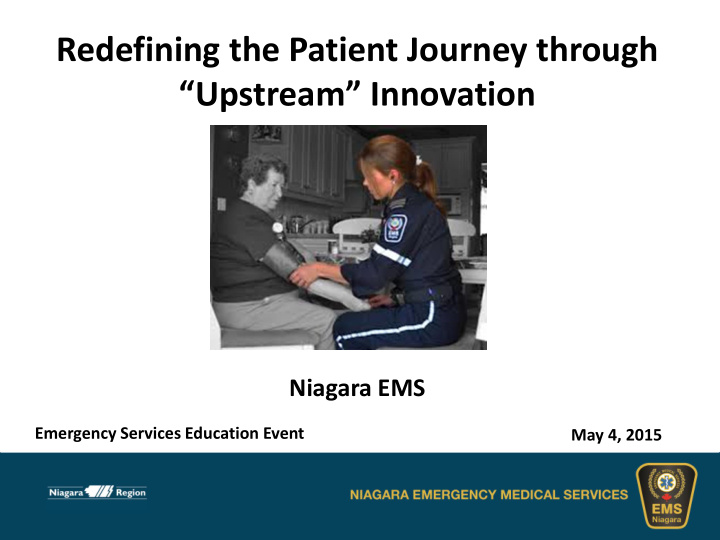



Redefining the Patient Journey through “Upstream” Innovation Niagara EMS Emergency Services Education Event May 4, 2015
Niagara in Comparison to the Rest of Ontario Niagara compared to rest of province: • Higher number of seniors • High incidence of chronic disease • Pockets of low socioeconomic status • Some communities challenged with accessing health care 2
Impact of System Pressures • EMS – off load delays, increased emergency response time, increased call volumes • Hospitals – staffing pressures and resource restraints including closures of smaller EDs • Physicians – time pressures • Community – insufficient funding for community programs
How do these System Pressures affect Care for our Patients? • Gaps in the trajectory of the patient journey as they try to navigate the health care system – Absent or inefficient care networks – Inability to navigate the resources that are available – Patients who use EMS as primary care – High risk patients discharged from hospital who are complex both medically and socially
University of Sheffield’s Medical Research Unit 1 “Central to each (country’s) vision is the concept of providing pre-hospital care as a system, rather than just a single service type, that can provide a flexible response to a wide range of condition types in collaboration with other related healthcare providers. “ (Sheffield, pg. 44) University of Sheffield, Medical Research Unit (2011). Building the Evidence Base in Pre-Hospital Urgent and Emergency Care. Sheffield: University of Sheffield, Medical Research Unit.
Opportunity Exists to Build an Evidence Based “Holistic” System of Pre-Hospital Care
Omega Study • Matches the patient's health care needs with the appropriate level of service • Safely manages the growing demands on health care providers • Reduces the demand on ambulance transportation services • Reduces emergency room visits and wait times http://www.prioritysolutionsinc.com/psiam_software/introduction_to_psiam.html
What we know to date Phase 1 – Modeling – Retrospective Analysis Phase 2 – Exploratory Trial – Prospective Analysis
OMEGA Phase 2 Run in Data N=298 Hypothetically diverted (53.5%) Ambulance arrived before CA Incomplete Although the CA’s may not have finished (4.5%) recommended hypothetical diversion from questioning Hypothetically the ED, 10.5 % of those calls did not diverted hypothetically recommended alternate (42%) transport (non-ambulance).
Community Paramedic Program 1. Collaboration with key health care stakeholders through value stream mapping of community defined needs and building referral pathways 2. Expansion of the Community Paramedic Program in Wainfleet – enhancements Oct. 1 2015 3. 1 Community Paramedic to service patients in Welland, Port Colborne and Pelhem - Jan. 16 2015 4. 1 Community Paramedic to work with 1 Community Services Worker and 1 Rapid Response Nurse service area of St. Catharines, Thorold, Niagara on the Lake, Niagara Falls, Fort Erie – Just started
Enhancement of Wainfleet Community Paramedic Program
Community Paramedics in Wainfleet • 26 patients currently rostered • Seniors (65 and older) • Complex needs and at risk with primary focus of: – Falls prevention – Heart disease – COPD • Identified via 9-1-1 calls, Niagara EMS database or primary care provider
Niagara South West Health Link - One fulltime Community Paramedic
Community Paramedic Activities in Niagara South West Health Link • Servicing Welland, Port Colborne and Pelham • 21 patients rostered • Mostly 65 and older • Complex needs and at risk with a primary focus of: – CHF – COPD – Mental Health – Addictions Patients are high EMS/hospital users
Role of Community Paramedic Timely alerts of admissions or discharges to/from ED and hospital to Primary Care Provider Home visits with report to primary care, liaise with CCAC if patient has care coordination Respiratory/cardiac/diabetic/nutrition education Falls Risk Assessments with ensuing referrals as required Provide and follow recommendations as given by primary care in conjunction with care coordinator Ensure follow up appointments are made and kept with primary care
Community Paramedic Program Activities cont’d • Assist with Medication reconciliation – Use patient’s or Health Link’s pharmacist • Referral to Existing Community Support Programs – Help supplement a client’s needs in the home (e.g., Caring for My COPD, Safety at Home, CCAC, South Niagara Health and Wellness, Mental Health, Alzheimer’s Society) • Case discussions with Medical Oversight – Dr. Jeff Remington
Enhanced Training Tailored to Community Needs New skill set for paramedics in response to community needs: • Falls Prevention Training • Cardiac/Diabetic Education Training • Enhanced COPD Training • Food Advisor Training • Enhanced ACS/Cardiac Education • Home Exercise Support
Community Paramedic Program Activities • Teach- back’s and check- in’s: – Note, by telephone via clinical advisor, RN, embedded within Niagara Ambulance Communications Centre
Referral Agencies and Linkages 3 4 CCAC 1 1 Primary Care Provider 2 1 Pharmacy 1 Caring for my COPD 1 Safety at Home Alzheimer's Society 2 6 Red Cross VON 1 Niagara South Health and Wellness 1 March of Dimes 1 United Way 1 Hope House 1 6 Gatekeeper Niagara 1 CAMH 1 1 Niagara Region Mental Health 3 3
Documentation of all visits
Recommend
More recommend